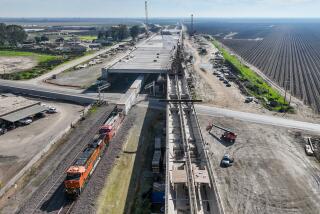Porter Ranch Report Links Jobs, Housing
A city consultant’s report paints a rosy picture of how the massive Porter Ranch development would provide jobs, shopping and housing that would reduce the need for long commutes by thousands of residents of the San Fernando Valley area and eastern Ventura County.
But the report, the latest chapter in a continuing debate over the 20-year project, also noted that tailoring a development to improve a regional jobs-housing balance has never been tried. It says that projecting the affordability of homes or income levels of workers is too speculative to attempt.
The report, prepared for the Los Angeles city Planning Department, is expected to be released later this month. A copy was obtained by The Times.
In general, the firm’s report concluded that the Porter Ranch development would draw workers and shoppers from predominantly residential areas of eastern Ventura County, such as Simi Valley and Moorpark, contributing to a better balance of jobs and houses in a region extending from eastern Ventura County to the Ventura Freeway Corridor and Burbank.
The report defined that region as everything within a 30-minute commuting radius of the Porter Ranch site in Chatsworth. Last year, the Porter Ranch project came under criticism from the Southern California Assn. of Governments for creating too many jobs in an area that it said already has a balance of jobs and houses. That would run counter to SCAG’s goal of reducing commuter traffic.
The Porter Ranch Development Co., which wants to build nearly 6 million square feet of commercial space and 3,395 residences on a scenic mountain slope north of the Simi Valley Freeway in Chatsworth, has maintained all along that the 1,300-acre project will shorten regional commuting times by creating jobs and shopping opportunities.
PRIDE, a Porter Ranch residents’ group, has disagreed, saying the proposed commercial complex is simply too big for the area.
The proposal is awaiting action by the Los Angeles City Council. Earlier this year, a council committee ordered that a supplemental environmental impact study analyze several key issues in detail, such as how the proposal would affect the balance of jobs and housing in the San Fernando Valley area.
As a part of that environmental study, a Los Angeles consulting firm, Hamilton, Rabinovitz & Alschuler, delved into the jobs-housing question for the city Planning Department.
The 30-minute commuting radius the study employs--which reaches into Ventura County areas that SCAG did not consider--”makes far more sense to us than the one-sided type of analysis that SCAG was doing,” said Frank Fielding, senior city planner for the San Fernando Valley. He added, however, that city planners still are evaluating the consultant’s conclusion that Porter Ranch would improve the jobs-housing balance.
“The figures seem to show that at this point in time, but we’re still working on it,” Fielding said.
Paul Chipello, executive director of PRIDE, said he continues to believe Porter Ranch will not promote a jobs-housing balance.
“The whole goal of jobs-housing balance is not to create larger commercial centers that create longer commuter distances,” Chipello said. “It’s a dinosaur. It’s an idea we need to get away from.”
The consultant’s report also noted that planning a development to improve a region’s jobs-housing balance is a new and untested endeavor. No national, state or regional standards exist for such a policy, which “requires a period of testing and experimentation,” the report said.
Moreover, achieving an “optimal” jobs-housing balance requires balancing workers’ wages with their ability to afford housing in the same area, the report said. The report estimated the number of jobs the project would create at 21,358.
But the report declined to project wage levels and housing prices, saying such an exercise would be too speculative. Instead, the report referred to the developer’s examination of those factors at today’s levels, which showed Porter Ranch workers would be able to afford housing nearby.
Phillip Fernando, a SCAG senior planner, said that although his agency has not yet seen the report or officially commented on it, he believed some projections of housing prices and wage levels should be attempted.
“What they are saying is it’s hard to do that, but I don’t think that’s a valid way of settling it,” Fernando said.
More to Read
Sign up for Essential California
The most important California stories and recommendations in your inbox every morning.
You may occasionally receive promotional content from the Los Angeles Times.










